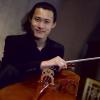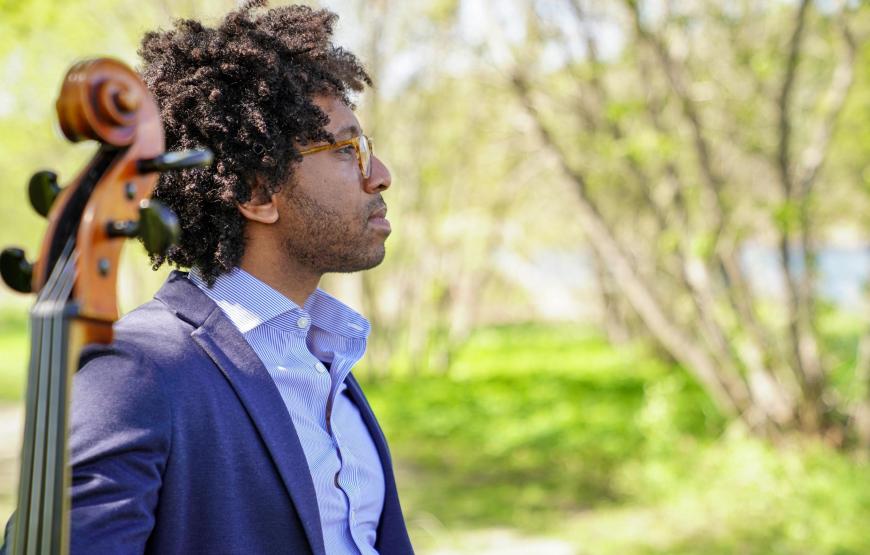
He’s been hailed by The Guardian as “a cellist of power and grace,” one who possesses “mature artistry and willingness to go to the brink.” He’s Seth Parker Woods, a Ph.D. who last April joined the faculty of USC Thornton as an assistant professor of practice and is this year’s recipient of the Chamber Music America Michael Jaffee Visionary Award. Indeed, Woods, 38, has established a reputation as a versatile artist who straddles several genres.
And he’ll be doing just that on Dec. 4, when he collaborates with dancer Roderick George in a new version of his evening-length work Difficult Grace, a multimedia concert presented by UCLA’s Center for the Art of Performance at the Glorya Kaufman Dance Theater. Conceived by and featuring Woods in the triple role of cellist, narrator/guide, and movement artist, Grace also features film, spoken text, and visual artwork in its semi-autobiographical exploration of identity and personal growth that draws inspiration from a myriad of sources, including the Great Migration and the historic newspaper The Chicago Defender.
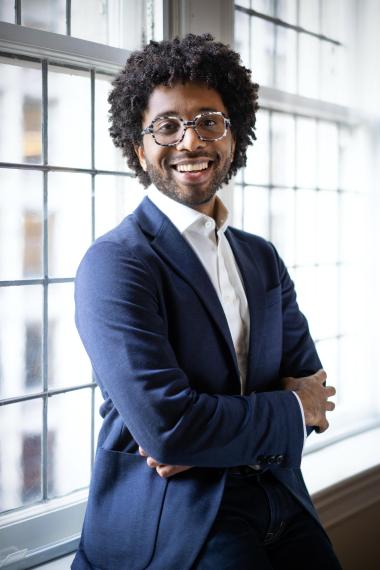
Woods, a native of Houston, holds degrees from Brooklyn College, Musik Akademie der Stadt Basel, and a doctorate from the University of Huddersfield in the U.K. In addition to his many solo performances, the cellist has appeared with ensembles such as the Basel Sinfonietta, Orchestra of St. Luke’s, and the Atlanta and Seattle Symphonies. An intrepid traveler, Woods in recent years has also performed at the Royal Albert Hall for the BBC Proms, at Belgium’s Ghent Festival, and with Italy’s Ensemble L’arsenale.
Constantly seeking to expand musical horizons, Woods’s Iced Bodies was a contemporary reframing of the legendary avant-garde collaboration in 1972 between the maverick designer Jim McWilliams and the late cellist and performance artist Charlotte Moorman. While the latter used a saw and other tools to play a cello sculpted from ice as it melted, Woods’s 2017 rendering saw him pushing the sonic envelope, as the sounds of dripping and crackling ice were amplified and electronically processed.
SF Classical Voice caught up with the fiendishly busy musician to discuss Difficult Grace and his attraction to new music.
Was there music in your family, and why the cello?
My father was a musician, and all of my siblings played music. I first came across the cello as a young kid in the [1987] movie The Witches of Eastwick. Susan Sarandon played a cellist, and from that first introduction, I started at an elementary school that had a strong arts and science program.
You’ve said that you’re “trying to change the face and the landscape in which music can be experienced, regardless of class or ethnicity or background.” Do you think you’re succeeding and, if so, in what ways?
I don’t know if I’m succeeding. I’m just trying to give a different lens to express myself and the stories that have come before. For so long, we’ve been taught that we’re just vessels for this music, for these composers. We [African Americans] also have our own narratives, whether they’re in our bodies as the voice or the cello, trumpet or timpani, or whatever the things are.
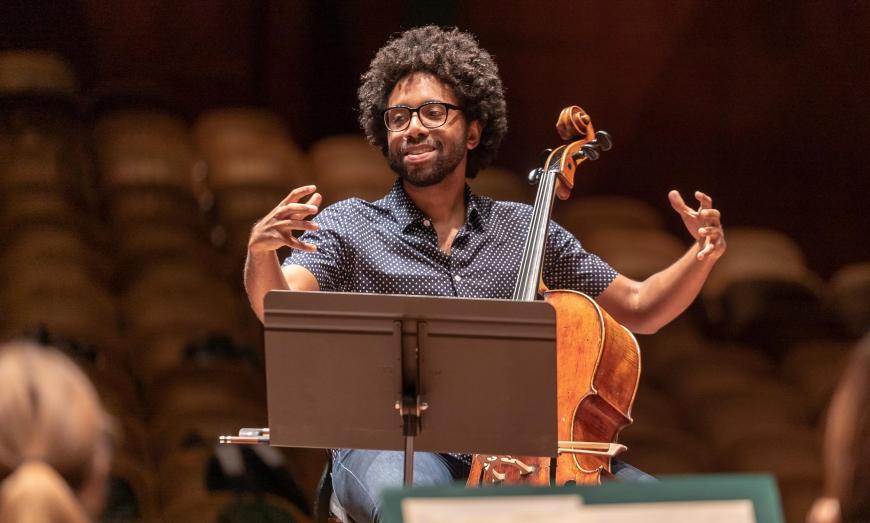
For me, I started realizing there are so many stories that get lost, that we should have more choices in what to put out there — and be a reflection of who we are. In some of those ways, I pushed myself to tackle works. The Ice(d) Music/Cello/Bodies — does the world really need this? These socio-poetic alignments I wanted to put to the forefront, and the cello — or iced cello — becomes a conduit for that. Even on a wooden cello, I’m not reinventing the wheel, but I’m trying to envision new ways performers can be seen and [create] experiences that are inspiring new or old generations to be more open or to go out on a limb.
You’re certainly doing that with Difficult Grace. What was the work’s genesis, and where does the title come from?
“Difficult grace” is a line from a poem by Dudley Randall. He started the Broadside Press in Detroit in the ’60s. His work caught me off guard when it was first introduced to me in 2017. When I talk about it now to audiences, people don’t know who he is, [but] he was bringing poetic voices of that time or before because they had to go under monikers. His printing press allowed voices to go out.
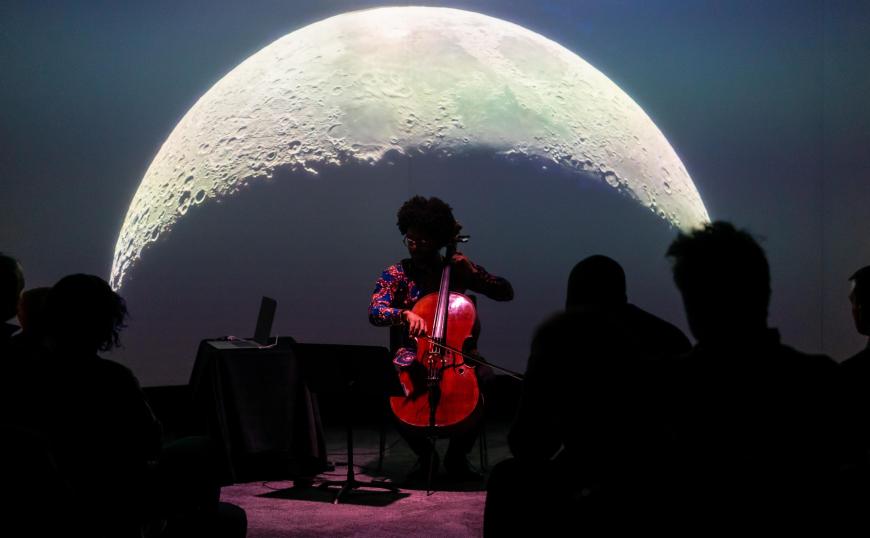
Looking at this time in the ’60s — it’s fiery in Detroit, and there’s a lot going on. You can feel the frustrations of what’s happening in the country. At the core, if we look around and survey where we are and what we’re doing, it feels as if it’s not working and it might be better to burn it all down. I was the artist-in-residence with the Seattle Symphony in 2018 and had been reading Dudley’s work, so as part of the opening of their concert hall, that became the idea, and out of that poem I commissioned a series of pieces with film, electronics, etc. One of the pieces, by Frederick Gifford, was created using the entire poem. That’s where the ball started rolling.
At the time I didn’t know what the full show was going to be. The show, in and of itself, even in that it was so steeped in archives, looking at the past — stories that had gotten lost, other works commissioned for that concert — that work is also rooted directly in the works from Jacob Lawrence’s [60-panel] Migration Series.
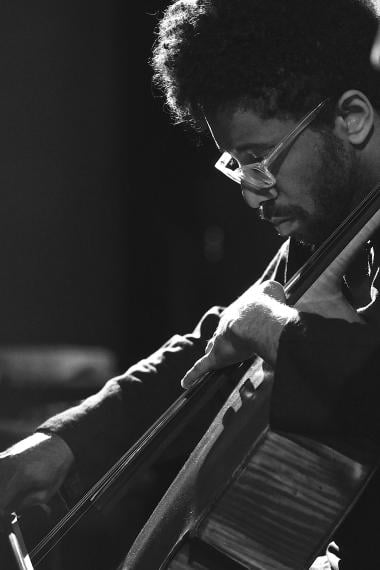
All of the music, which was written for you and also includes works by, among others, Devonté Hynes, Ted Hearne, and Freida Abtan, is also blended with a visual narrative.
Yes. There’s only one piece from 1970, and that’s by Coleridge-Taylor Perkinson [1932–2004]. Most of the visual media is in the first half of the show, and there’s quite a bit of it. The composers have filmmakers they worked with. The title piece has visual works of Barbara Earl Thomas, the last protegee of [dynamic cubist painter] Jacob Lawrence. She’s still living, and I met her in Seattle. Her artworks are incorporated into Difficult Grace, and one of the big pieces I used from her was a mixed-media paper sculpture.
Your research also had you looking back to the year 1915.
Yes. There’s an interesting shift in language, in narratives and ownership — in empowerment. In 1915, it starts to shift. As time goes on, things change in the language, but the stories that came out of that and the things happening in 1915 were being reported on. It becomes another thread that links it together and is a way to look at the past. [African Americans] were trying to flee, to find a better way of life, which was not in the South; they went to L.A., Chicago, Houston, New York.
It was interesting to look at from an archival dig. Rooted in that, the larger thing is looking at adornment — physical, metaphorically. Zora Neale Hurston wrote a book, and in it she has an essay, “The Will to Adorn.” She uses examples of church ladies, the gospel church, [and] the way of using hats as empowerment, as a shield in a way.
The migration was still happening in 1940, and the vividness in that is in a composition by Nathalie Joachim. In a way, I don’t have one central theme that can be all encompassing. For me, it’s looking at the body, the history, how we’ve positioned ourselves, how we’ve grown, how we move forward, and how we celebrate ourselves and those around us, our communities.
It’s challenging in some ways. I speak text from The Chicago Defender that can feel heavy at times. I’m a conduit for these people’s stories. They’re not my words, but I’m a vessel for it. There’s a lot of emotion, reflection, celebration, and joy inside it.
What attracts you to collaborations with other artists, and why do you feel it’s your responsibility to champion new music?
I spent so much time, like so many concert musicians, playing dead people’s music. Even before that, when I was 16 or 17, I had a great teacher, the late André Emelianoff from The Juilliard School. He was the founding cellist of the Da Capo Chamber Players, and part of [their] ethos was to champion living composers. They also played warhorses, but there was a chance to play the music of now. So many students were encouraged to play new music, living music.
After that, I’m in school, I’m studying, and there are all these young composers around. If they needed their music played, I could talk to an actual composer — what they want, what they’re intending to do. That exploration, digging, archiving, I found very interesting because I’m trying to bring those new works to life and couple them with older works — have them be in conversation with each other.
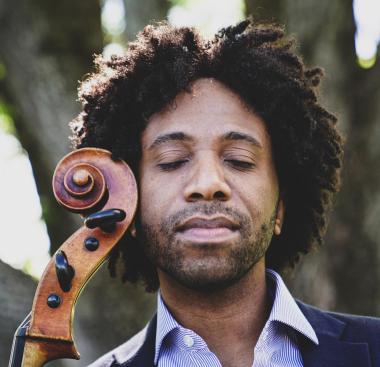
Where do you see yourself in the next five to 10 years?
I feel like I’m just getting started, not fully started, but I’ve arrived to a new chapter. There’s something on my mind — what does 40 mean to me, to the Virgo in me? By 40, what I really want to do, and will start putting this into play, is commission a series of works, like a marathon of works to culminate 40 years. I also want to bring back a few pieces that have shaped me and been with me that are a celebration of life, friendship, and collaboration.
Hopefully I’ll still be in Los Angeles. Part of my reason for taking the job of professorship [at USC] is that I’ve been moving since I was 17 — a few years here, another city, another country there. I’m tired of starting over and having to rebuild everything, so for me, I’d like to create a solid base here.
And L.A. has been kind to me over the years. I moved back to the States in 2016, and my first concert was in 2017 [playing the music of] Julius Eastman, and I’ve been coming back here more and more over the years, cultivating friendships. I also have longtime friends. I like it here. I’m also kind of done with snow.
What advice do you have for young cellists?
I would say be open. That’s the best thing. You may not save lives, but you’ll save souls. It’s just music, not brain surgery.



